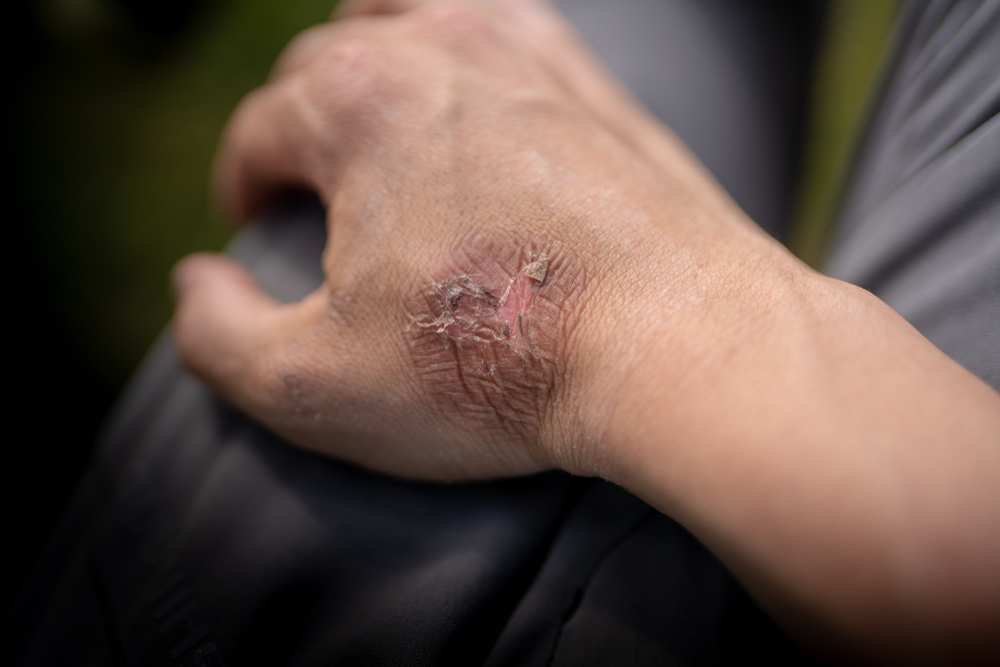Burn injuries contribute significantly to the global morbidity and mortality rates every year. Depending on the nature of the burn, the severity, and the depth of injury, approaches to burn management will vary.
Defining Partial Thickness Burns
Partial-thickness burns involve both the upper layer of the skin (epidermis) and the lower layer (dermis) to varying extents. Damage may or may not manifest physically as blisters, but pain although delayed is almost always a constant feature. Partial-thickness burns can be categorized into superficial and deep partial-thickness burns.
What Is a Superficial Partial Thickness Burn?
A superficial partial-thickness burn is a thermal, electrical, friction, radiation, or chemical injury to the skin that extends through the epidermis to the upper portion of the dermis (papillary dermis). This type of burn manifests as erythematous, blanching skin with severe pain.
Etiology/Risk Factors
Although individuals of all ages are affected by burn injuries, children and elderly persons have a higher risk of sustaining burn injuries. The increased risk is due to a lack of perception of the imminent danger of their actions, or a reduced awareness of hazards in their surroundings due to age-induced loss of sensory capabilities. In adults, the risk of sustaining a partial thickness burn is associated with increased exposure to thermal, radiation, and electrical sources at home or in workplaces.
Signs and Symptoms
Superficial partial-thickness burns manifest with the following symptoms:
- Erythema (redness) resulting from acute inflammation following the burn
- Blistering (fluid-filled vesicles)
- Increased skin moisture
- Blanching on pressure application at the affected area
- Severe pain due to exposure of nerve ending close to the skin surface
- Dehydration resulting from loss of skin continuity
- Infection with suppuration
Diagnosis
Diagnosis of superficial partial-thickness burns is done clinically using a physical examination and assessment charts. The presence of the clinical signs previously mentioned in combination with an assessment of the burn depth and severity are all integral to correctly diagnosing a superficial partial-thickness burn. Burn extent estimation can be performed using the Lund and Browder chart, or very commonly, the Rule of Nines. Depth categorization can be done clinically by surgeons or with the aid of laser Doppler technology.
Treatment
The strategies for treating superficial partial-thickness burns are based on measures to control the symptoms. Key principles include:
- Pain control
- Wound cleaning
- Wound dressing
- Infection control with antibiotics
- Managing dehydration
- Other care blood tests, tetanus prophylaxis, anti-itch meds
Pain Control
For a significant majority of patients, the immediate concern will be managing the exquisite pain associated with this category of burns. Non-steroidal anti-inflammatory drugs (NSAIDs), and opioid analgesics, represent some drug classes that can be used to treat burn-associated pain. The prescription approach should follow the WHO pain ladder with more potent analgesics given for more severe pain.
Wound Cleaning
Except for small blisters on palmar skin, all other blisters formed from partial-thickness burns can be removed to allow for a proper assessment, as well as cleaning. Wound irrigation can be done with saline or other commercial surfactants to eliminate foreign bodies that might have been introduced into the burn site following a skin breach.
Wound Dressing
Daily wound dressings with wound cleansing before the application of dressing materials is an effective way of managing superficial partial-thickness burns. Wound dressing with petrolatum or silver-impregnated gauze will provide a moist environment that improves re-epithelialization at the wound site.
Infection Control with Antibiotics
Like with other skin injuries, partial-thickness burns expose patients to the risk of sepsis which is eliminated by the use of appropriate antibiotics. Antibiotic use in superficial partial-thickness burns is typically limited to the topical route of administration. Common topical preparations include silver sulfadiazine and mafenide acetate. These antibiotics can be applied directly as a cream over a burn wound surface or as part of impregnated gauze.
Managing Dehydration
A loss of the normal protective barrier formed by the skin can expose burn patients to varying degrees of fluid loss. The possibility of a patient getting dehydrated should always be considered in burn wounds. The majority of patients who sustain partial thickness burns will be stable enough to drink and eat and should be encouraged to consume fluids liberally. In cases where oral fluid intake is impossible, intravenous fluids should be administered as required to maintain satisfactory hydration levels.
Other Care Procedures
Other aspects of treating superficial partial-thickness burns include:
- Tetanus prophylaxis to eliminate the risk of developing fatal disease
- Anti-itch medications to control skin itching during wound healing
- Biological wound dressings
- Topical recombinant growth factor application
Prevention of Burns
Some key burn prevention strategies are listed below:
- The use of personal protective equipment in environments where there is an increased risk of thermal, electrical, radiation, or chemical burns
- Education of individual on the dangers of fire, electricity, and other potential burn sources
- Avoiding the use of faulty equipment/devices at home or at the workplace.



.webp)

.avif)